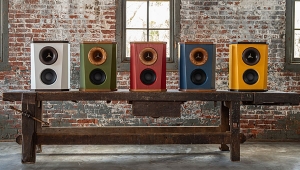| Columns Retired Columns & Blogs |
BATmen: Victor Khomenko & Steve Bednarski Page 2
Deutsch: Isn't it the case that you're going to end up with roughly twice the parts cost?
Khomenko: Even that's not necessarily true. If you look at the parts cost of the Khomenko-5, a fully balanced differential design, it's not substantially higher than many single-ended designs. There are many different ways of building balanced circuits. The word "balanced" is interpreted in so many ways. Recording engineers talk about one type of balanced interface. If you talk to instrumentation designers, they mean something different. I saw one article in which there was a very clean, simple representation of a single-ended circuit, and there was a half-page drawing of something very ugly, which was the representation of the balanced circuit.
It doesn't have to be that way. You certainly can design that way, but you can apply the rule of simplicity to either circuit. You can make a very simple and elegant design in balanced. The design philosophies overlap tremendously. Balanced differential stages are commonly used in single-ended components as well. Our approach has always been of utmost simplicity. I was taught very early in my career that a good engineer is a lazy engineer—you can't be a good engineer if you make something very complicated; it probably won't work very well or be very reliable.
Bednarski: If you just took a single-ended circuit and doubled it to make it balanced, you would end up with twice the cost. However, what Victor has done is to take a clean sheet of paper to design a balanced circuit that could be brought to the market with a high degree of performance, minimizing the number of stages and eliminating buffers between stages, without a price premium over single-ended designs.
Deutsch: What was more difficult to design and produce—the preamp or the power amp?
Khomenko: The power amp is much heavier! Your back really hurts carrying the prototypes around. The power amp probably is more difficult to design, simply because you have more potential danger; failure in many cases is catastrophic. You have to pay substantially more attention to reliability. In terms of designing for good sound, they're similar, but the power amp may be more difficult still because of the output transformer design. Output transformers have received a lot of bad press—and justly so—because there are many mediocre transformer designs, so that they're often the limiting factor in overall performance. I think it's important to identify ways—as I think we've done in the Khomenko-60—to eliminate those difficulties in transformer design. We made the transformer's design very easy, and achieved, I think, tremendous performance.
Deutsch: How would you describe your design process?
Khomenko: I was taught to approach every problem from an analytical perspective. Analyze what you're trying to do and know your ways of achieving it, then take your best shot. You have to do a lot of forward thinking, forward analysis. Only then do you jump into building something. We try to implement the same approach with every product we design. We don't just take something that kind of works and just tinker with it. Every circuit we designed so far played well on paper before the first prototype was built. We do extensive computer circuit analysis. The results are very rewarding, because usually the first prototype already sounds very good. You then start tweaking and modifications, but you can't do successful tweaking and modifications unless you have an almost perfect vehicle to begin with.
Deutsch: How much of the performance of a given product is determined by the basic design as opposed to parts selection and tweaks?
Bednarski: I can't put a percentage on it, but I can tell you about a comparison I've made. I have a Dynaco Stereo 70 that has been modified to the hilt: custom output transformers, beefed-up power supply, KT90 tubes, custom oil capacitors. It's the nicest-sounding Stereo 70 I've heard, but it doesn't come close to the sonic performance of a Khomenko-60. I could spend from now until eternity tweaking the fundamental Stereo 70 circuit, but I don't think I could do anything that would allow it to attain the performance of the Khomenko-60.
Having said that, parts selection certainly has its rewards.
Khomenko: I believe that basic circuit topology is paramount. Parts selection and tweaks are important, but unless your platform is very good, it won't give you access to great performance. It's like modifying a Chevette as opposed to modifying a stock Porsche.
Bednarski: Something that I've noticed among friends is that when they start tweaking products that they've purchased, the results are often far from satisfactory. Supposedly better capacitors may be put in a crossover, and what was a finely balanced speaker is all of a sudden harsh and irritating.
- Log in or register to post comments




































